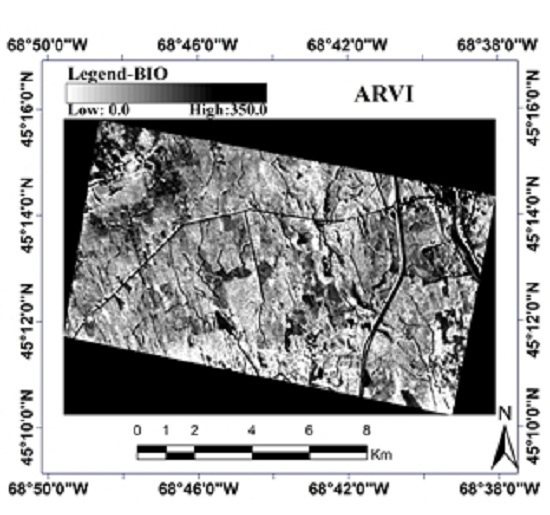The Potential of Forest Biomass Inversion Based on Vegetation Indices Using Multi-Angle CHRIS/PROBA Data
Abstract
:1. Introduction
2. Materials and Methods
2.1. Study Site
2.2. Field Samplings
2.3. Satellite Data
2.4. The Building of a Look-Up Table
2.5. Data Analysis
3. Results
3.1. Comparison Nadir Angle with Off-Nadir Angle
3.2. Band Effects on Biomass
3.3. View-Illumination Effects on Biomass
3.4. Biomass Estimation
4. Discussion
5. Conclusions
Acknowledgments
Author Contributions
Conflicts of Interest
References
- Kimes, D.S.; Ranson, K.J.; Sun, G.Q.; Blair, J.B. Predicting lidar measured forest vertical structure from multi-angle spectral data. Remote Sens. Environ. 2006, 100, 503–511. [Google Scholar] [CrossRef]
- Jenkins, J.C.; Chojnacky, D.; Heath, L.S.; Birdsey, R.A. Comprehensive Database of Diameter-Based Biomass Regressions for North American Tree Species; General Technical Report NE-319; U.S. Department of Agriculture, Forest Service, Northeastern Research Station: Newtown Square, PA, USA, 2004; p. 45.
- Tritton, L.M.; Hornbeck, J.W. Biomass Equations for Major Tree Species of the Northeast; General Technical Report NE-69; U.S. Department of Agriculture, Forest Service, Northeastern Forest Experiment Station: Newtown Square, PA, USA, 1982; p. 46.
- Ni, W.J.; Sun, G.Q.; Ranson, K.J.; Zhang, Z.Y.; He, Y.T.; Huang, W.L.; Guo, Z.F. Model based analysis of the influence of forest structures on the scattering phase center at L-band. IEEE Trans. Geosci. Remote Sens. 2014, 52, 3937–3946. [Google Scholar]
- Pang, Y.; Li, Z.Y. Inversion of biomass components of the temperate forest using airborne Lidar technology in Xiaoxing’an Mountains, Northeastern of China. Chin. J. Plant Ecol. 2012, 36, 1095–1105. [Google Scholar] [CrossRef]
- Lefsky, M.A.; Cohen, W.B.; Parker, G.G.; Harding, D.J. Lidar remote sensing for ecosystem studies. Bioscience 2002, 52, 19–30. [Google Scholar] [CrossRef]
- Wulder, M. Optical remote sensing techniques for the assessment of forest inventory and biophysical parameters. Proc. Phys. Geogr. 1998, 22, 449–476. [Google Scholar] [CrossRef]
- Wang, Q.; Pang, Y.; Li, Z.Y.; Chen, E.X.; Sun, G.Q.; Tan, B.X. Improvement and application of the conifer forest multiangular hybrid GORT Model-MGeoSAIL. IEEE Trans. Geosci. Remote Sens. 2013, 51, 5047–5059. [Google Scholar] [CrossRef]
- Leroy, M.; Roujean, J.L. Sun and view angle corrections on reflectances derived from NOAA/AVHRR data. IEEE Trans. Geosci. Remote Sens. 1994, 32, 684–697. [Google Scholar] [CrossRef]
- Asner, G.P. Contributions of multi-view angle remote sensing to land surface and biogeochemical research. Remote Sens. Rev. 2000, 18, 137–162. [Google Scholar] [CrossRef]
- Asner, G.P.; Braswell, B.H.; Schimel, D.S.; Wessman, C.A. Ecological research needs from multi-angle remote sensing data. Remote Sens. Environ. 1991, 63, 155–165. [Google Scholar] [CrossRef]
- Diner, D.J.; Asner, G.P.; Davies, R.; Knyazikhin, Y.; Muller, J.P.; Nolin, A.W.; Pinty, B.; Schaaf, C.B.; Stroeve, J. New directions in Earth observing: scientific application of multi-angle remote sensing. Bull. Am. Meteorol. Soc. 1999, 80, 2209–2228. [Google Scholar] [CrossRef]
- Sandmeier, S.; Deering, D.W. Structure analysis and classification of boreal forests using hyper-spectral BRDF data from ASAS. Remote Sens. Environ. 1999, 69, 281–295. [Google Scholar] [CrossRef]
- Kimes, D.S.; Nelson, R.F.; Manry, M.T.; Fung, A. Attributes of neural networks for extracting continuous vegetation variables from optical and radar measurements. Int. J. Remote Sens. 1998, 19, 2639–2663. [Google Scholar] [CrossRef]
- Myneni, R.B.; Maggion, S.; Iaquinto, J.; Privette, J.L.; Gobron, N.; Pinty, B.; Kimes, D.S.; Verstraete, M.M.; Williams, D.L. Optical remote-sensing of vegetation-modeling, caveats, and algorithms. Remote Sens. Environ. 1995, 51, 169–188. [Google Scholar] [CrossRef]
- Verrelst, J.; Schaepman, M.E.; Koetz, B.; Kneubühlerb, M. Angular sensitivity analysis of vegetation indices derived from CHRIS/PROBA data. Remote Sens. Environ. 2008, 112, 2341–2353. [Google Scholar] [CrossRef]
- Jackson, R.D.; Teillet, P.M.; Slater, P.N.; Fedosejevs, G.; Jasinski, M.F.; Aase, J.K.; Moran, M.S. Bidirectional measurements of surface reflectance for view angle corrections of oblique imagery. Remote Sens. Environ. 1990, 32, 189–202. [Google Scholar] [CrossRef]
- Pinter, P.J.; Zipoli, G.; Maracchi, G.; Reginato, R.J. Influence of topography and sensor view angles on NIR/red ratio and greenness vegetation indices of wheat. Int. J. Remote Sens. 1987, 8, 953–957. [Google Scholar] [CrossRef]
- Roberts, D.A.; Roth, K.L.; Perroy, R.L. Chapter 14. Hyperspectral vegetation indices. In Hyperspectral Remote Sensing of Vegetation; Thenkabail, P.S., Lyon, J.G., Huete, A., Eds.; CRC Press, Taylor and Francis Group: Boca Raton, FL, USA, 2011; pp. 309–327. [Google Scholar]
- Garbulsky, M.F.; Penuelas, J.; Gamon, J.; Inoue, Y.; Filella, I. The Photochemical Reflectance Index (PRI) and the remote sensing of leaf, canopy and ecosystem radiation use efficiencies: A review and meta-analysis. Remote Sens. Environ. 2011, 115, 281–297. [Google Scholar] [CrossRef]
- Huete, A.R.; Kim, Y.; Ratana, P.; Didan, K.; Shimabukuro, Y.E.; Miura, T. Chapter 11. Assessment of phenologic variability in Amazon tropical rainforests using hyperspectral Hyperion and MODIS satellite data. In Hyperspectral Remote Sensing of Tropical and Sub-tropical Forests; Kalacska, M., Anchez-Azofeifa, G.A., Eds.; CRC Press, Taylor and Francis Group: Boca Raton, FL, USA, 2008; pp. 233–259. [Google Scholar]
- Chen, J.M.; Liu, J.; Leblanc, S.G.; Lacaze, R.; Roujean, J.L. Multi-angular optical remote sensing for assessing vegetation structure and carbon absorption. Remote Sens. Environ. 2003, 84, 516–525. [Google Scholar] [CrossRef]
- Wu, C.Y.; Niu, Z.; Wang, J.D.; Gao, S.; Huang, W.J. Predicting leaf area index in wheat using angular vegetation indices derived from in situ canopy measurements. Can. J. Remote Sens. 2010, 36, 301–312. [Google Scholar] [CrossRef]
- Jenkins, J.C.; Chojnacky, D.C.; Heath, L.S.; Birdsey, R.A. National-scale biomass estimators for United States tree species. Forest Sci. 2003, 49, 12–35. [Google Scholar]
- Barnsley, J.M.; Settle, J.J.; Cutter, M.A.; Lobb, D.R. The PROBA/CHRIS mission: A low-cost smallsat for hyperspectral multi-angle observations of the earth surface and atmosphere. IEEE Trans. Geosci. Remote Sens. 2004, 42, 1512–1520. [Google Scholar] [CrossRef]
- Guanter, L.; Alonso, L.; Moreno, J. A method for the surface reflectance retrieval from PROBA/CHRIS data over land: Application to ESA SPARC campaigns. IEEE Trans. Geosci. Remote Sens. 2005, 43, 2907–2917. [Google Scholar] [CrossRef]
- Kneubühler, M.; Kötz, B.; Richter, R.; Schaepman, M.; Ltten, K. Geimetric and radionmetric pre-processing of CHRIS/PROBA over mountainous terrain. In Proceedings of the 3rd CHRIS/PROBA Workshop, Frascati, Italy, 21–23 March 2005; pp. 59–64.
- Verrelst, J.; Clevers, J.G.P.; Schaepman, M.E. Merging the Minnaert-k parameter with spectral unmixing to map forest heterogeneity with CHRIS/PROBA data. IEEE Trans. Geosci. Remote Sens. 2010, 48, 4014–4022. [Google Scholar]
- Chan, J.C.W.; Ma, J.; van de Voorde, T.; Canters, F. Preliminary results of superresolution-enhanced angular hyperspectral (CHRIS/PROBA) images for land-cover classification. IEEE Trans. Geosci. Remote Sens. 2011, 8, 1011–1015. [Google Scholar] [CrossRef]
- Urban, D.L.; Bonan, G.B.; Smith, T.M.; Shugart, H.H. Spatial applications of gap models. Forest Ecol. Manag. 1991, 42, 95–110. [Google Scholar] [CrossRef]
- Gastellu-Etchegorry, J.P. DART User Manual. 2015. Available online: http://www.cesbio.upstlse.fr/dart/license/documentationsDart/DART_User_Manual.pdf (accessed on 27 October 2016).
- Gastellu-Etchegorry, J.P.; Martin, E.; Gascon, F. DART: A 3-D model for simulating satellite images and studying surface radiation budget. Int. J. Remote Sens. 2004, 25, 73–96. [Google Scholar] [CrossRef]
- Tucker, C.J. Red and photographic infrared linear combinations for monitoring vegetation. Remote Sens. Environ. 1979, 8, 127–150. [Google Scholar] [CrossRef]
- Richardson, A.J.; Everitt, J.H. Using spectral vegetation indices to estimate rangeland productivity. Geocarto Int. 1992, 7, 63–77. [Google Scholar] [CrossRef]
- Huete, A.R. A Soil-Adjusted Vegetation Index (SAVI). Remote Sens. Environ. 1988, 25, 295–309. [Google Scholar] [CrossRef]
- Huete, A.R.; Didan, K.; Miura, T.; Rodriguez, E.P.; Gao, X.; Ferreira, L.G. Overview of the radiometric and biophysical performance of the MODIS vegetation indices. Remote Sens. Environ. 2002, 83, 195–213. [Google Scholar] [CrossRef]
- Kaufman, Y.J.; Tanre, D. Atmospherically resistant vegetation index (ARVI) for EOS-MODIS. IEEE Trans. Geosci. Remote Sens. 1992, 30, 261–270. [Google Scholar] [CrossRef]
- Fang, X.Q.; Zhang, W.C. The application of remotely sensed data to the estimation of the leaf area index. Remote Sens. Land Res. 2003, 57, 58–62. [Google Scholar]
- Chen, J.M.; Leblanc, S.G. Multiple-scattering scheme useful for geometric optical modeling. IEEE Trans. Geosci. Remote Sens. 2001, 39, 1061–1071. [Google Scholar] [CrossRef]
- Galvao, L.S.; Breunig, F.M.; dos Santos, J.R.; de Moura, Y.M. View-illumination effects on hyperspectral vegetation indices in the Amazonian tropical forest. Int. J. Appl. Earth Obs. Geoinf. 2013, 21, 291–300. [Google Scholar] [CrossRef]
- Middleton, E.M.; Huemmrich, K.F.; Cheng, Y.; Margolis, H.A. Chapter 12. Spectral bioindicators of photosynthetic efficiency and vegetation stress. In Hyperspectral Remote Sensing of Vegetation; Thenkabail, P.S., Lyon, J.G., Huete, A., Eds.; CRC Press, Taylor and Francis Group: Boca Raton, FL, USA, 2011; pp. 265–288. [Google Scholar]
- Mäkelä, A.; Valentine, H.T. Crown ration influences allometric scaling in trees. Ecology 2006, 87, 2967–2972. [Google Scholar] [CrossRef]
- Vauhkonen, J.; Holopainen, M.; Kankare, V.; Vastaranta, M.; Viitala, R. Geometrically explicit description of forest canopy based on 3D triangulations of airborne laser scanning data. Remote Sens. Environ. 2016, 173, 248–257. [Google Scholar] [CrossRef]
- Fichtner, A.; Sturm, K.; Rickert, C.; Oheimb, G.; Härdtle, W. Crown size-growth relationships of European beech (Fagus sylvatica L.) are driven by the interplay of disturbance intensity and inter-specific competition. Forest Ecol. Manag. 2013, 302, 178–184. [Google Scholar] [CrossRef]
- Lacazea, R.; Chen, J.M.; Roujeana, J.L.; Leblanc, S.G. Retrieval of vegetation clumping index using hot spot signatures measured by POLDER instrument. Remote Sens. Environ. 2002, 79, 84–95. [Google Scholar] [CrossRef]
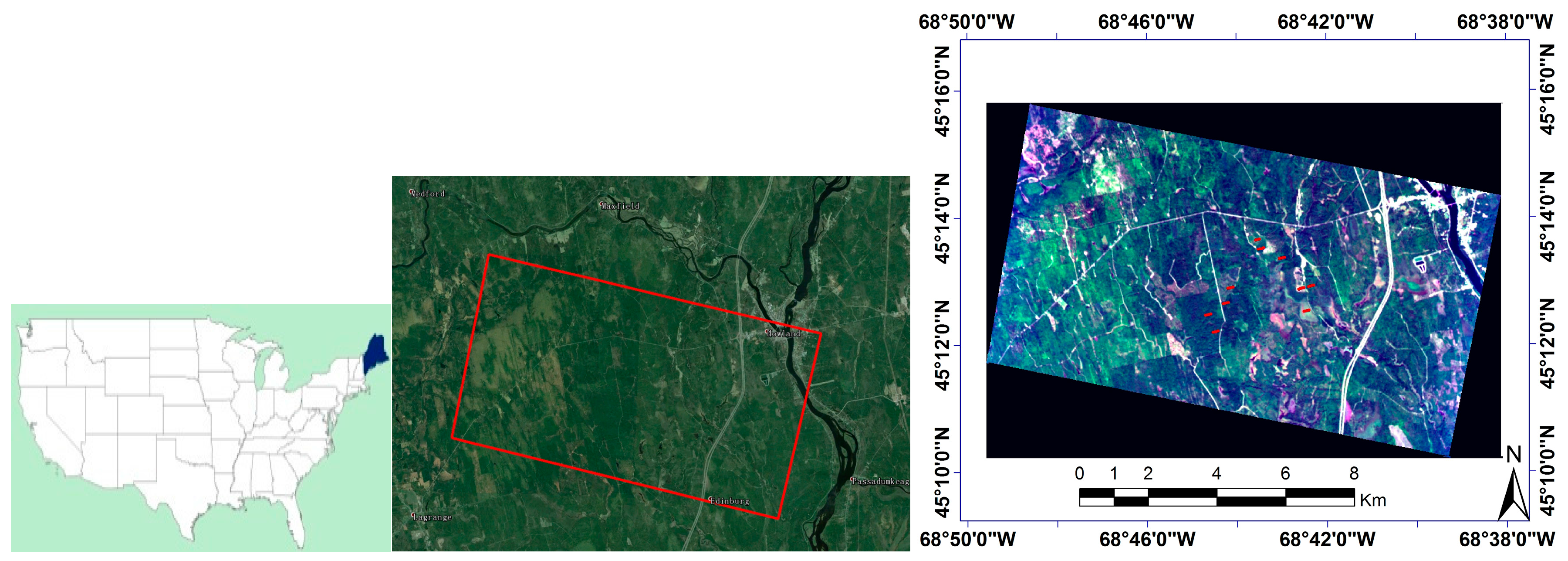
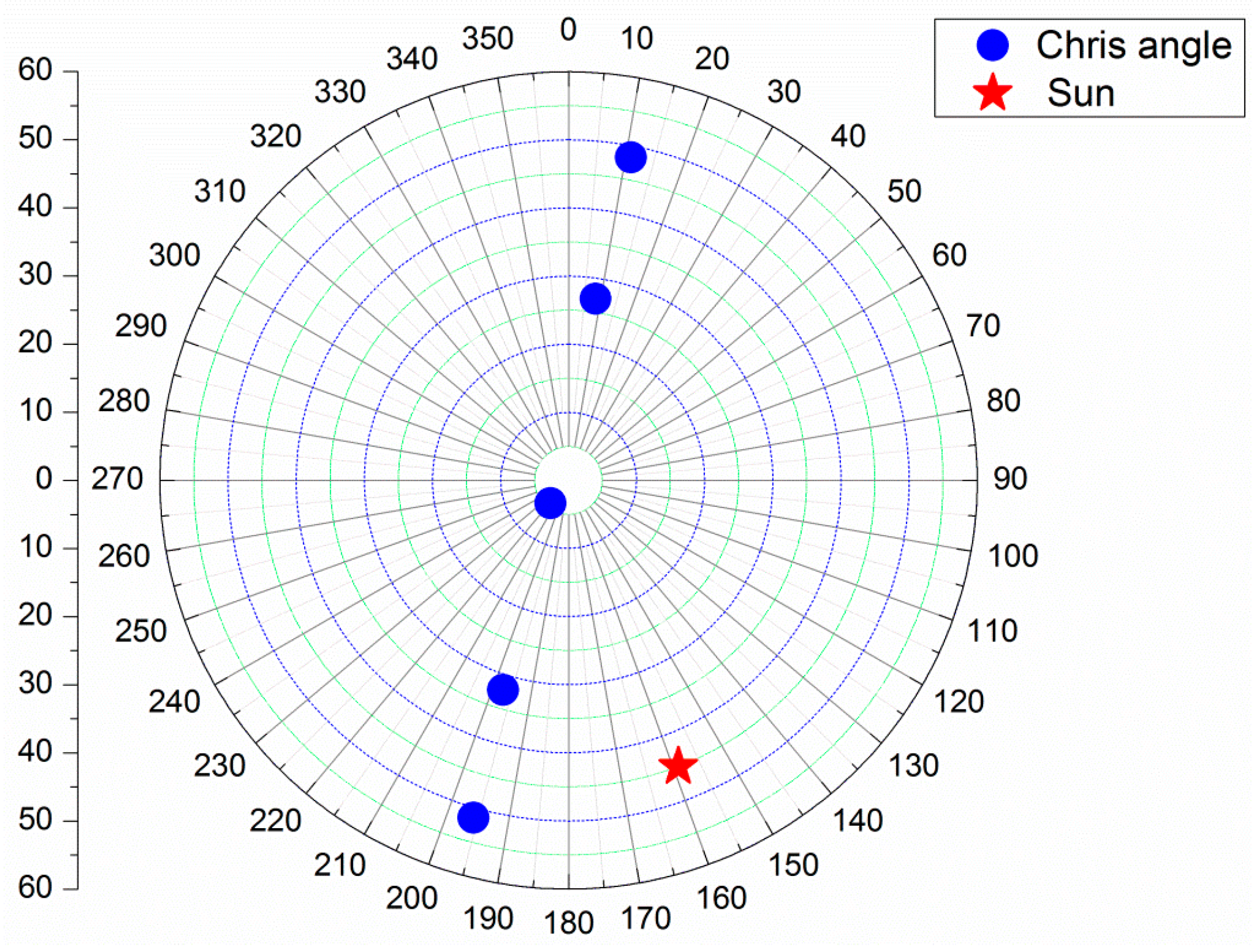
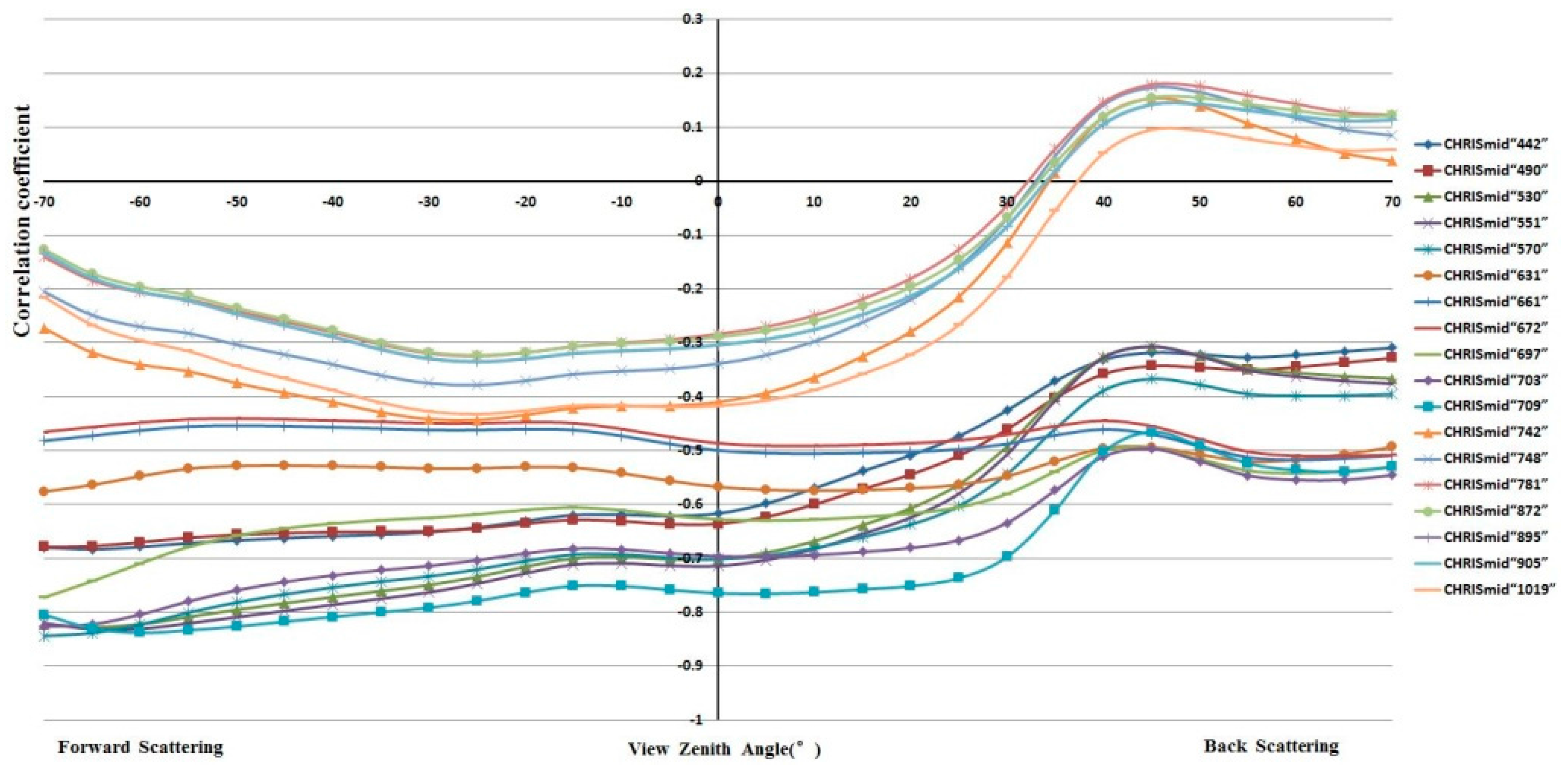

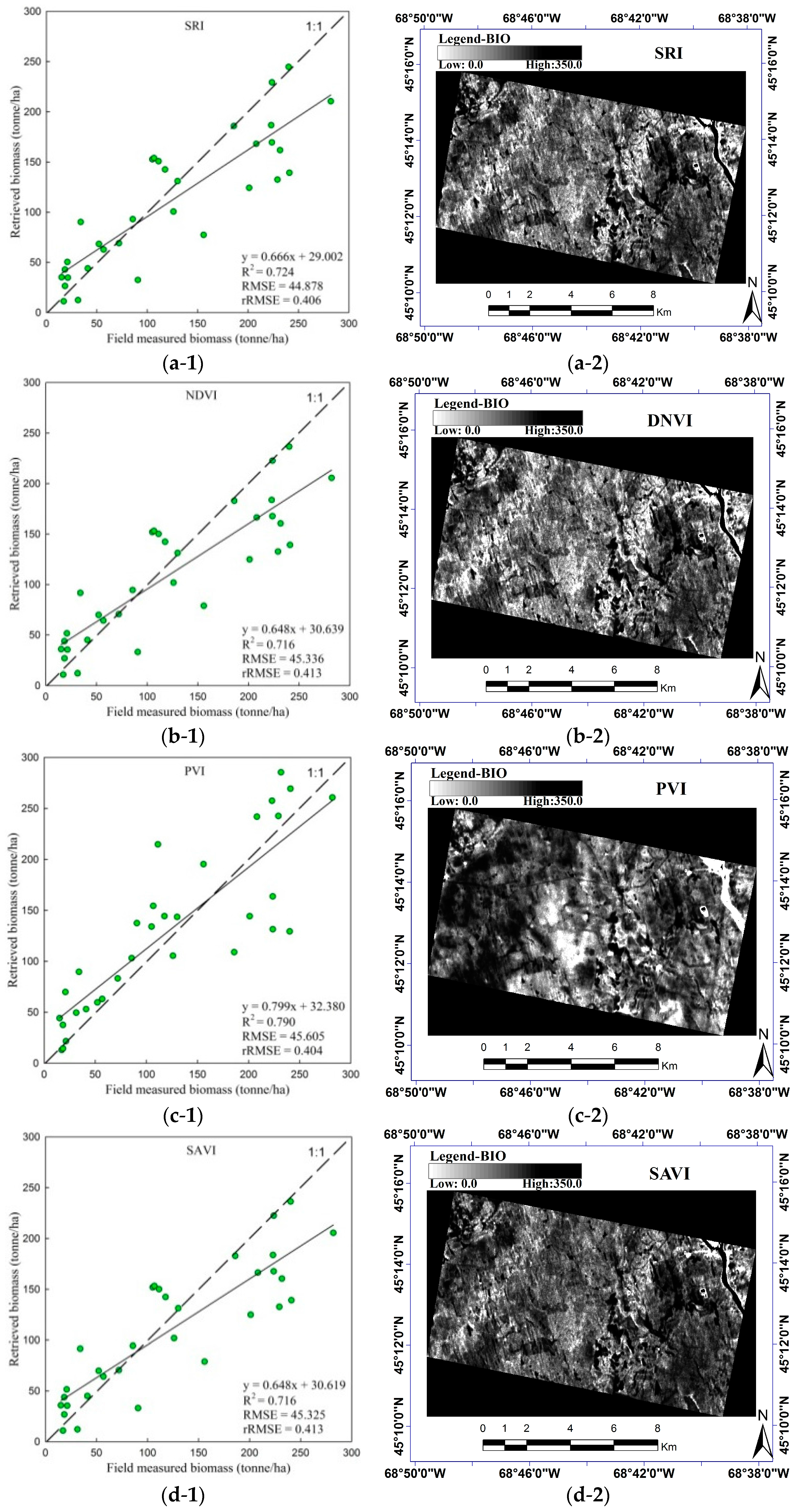
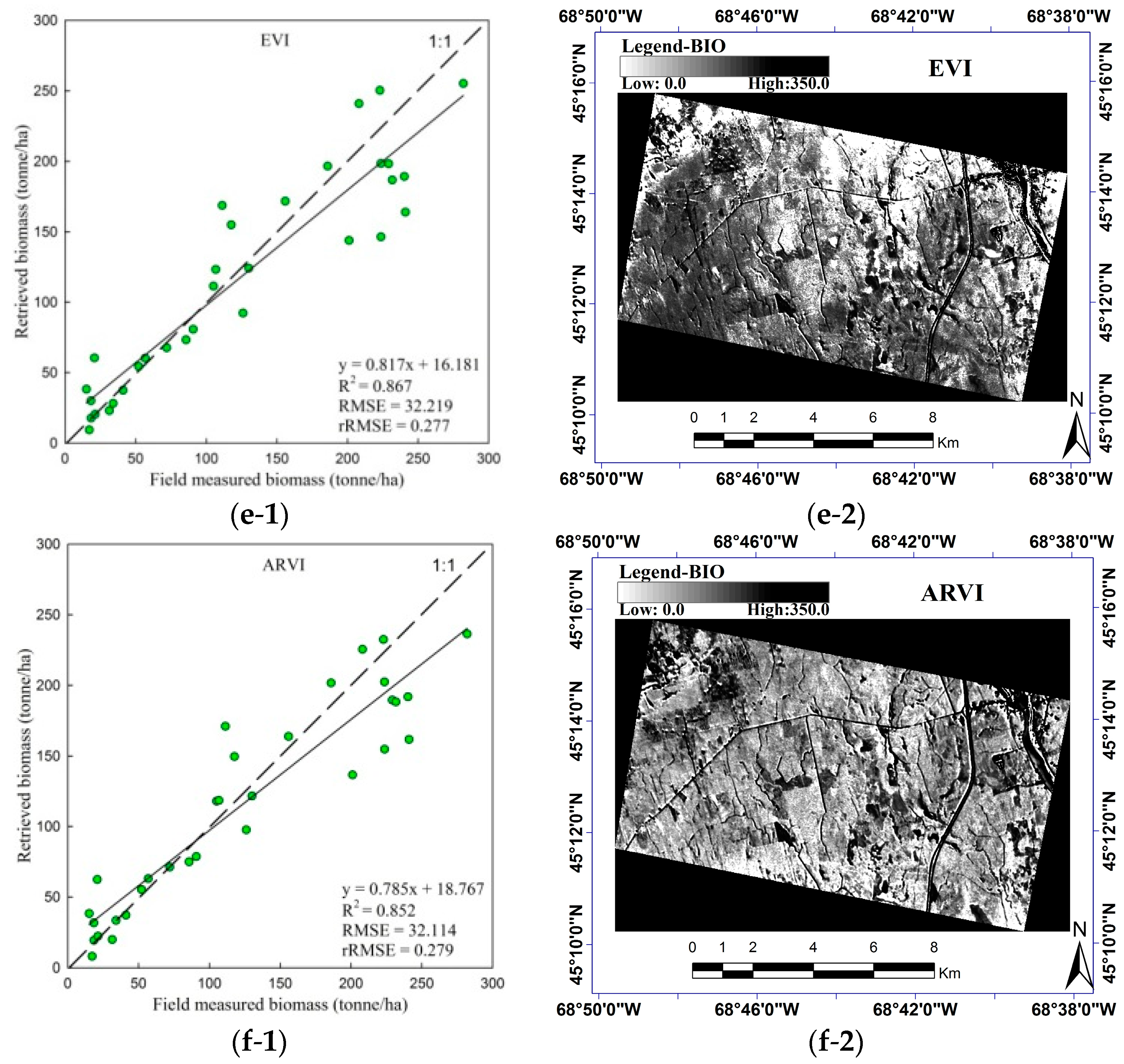
| Study Area | Image Area | Sampling | Central Latitude and Longitude | Viewing Angles | Spectral Bands | Sun Zenith | Sun Azimuth |
|---|---|---|---|---|---|---|---|
| Howland | 14 × 14 km (744 × 748 pixels) | 17 × 17 m @ 662 km altitude | 42°2′24′′ 127°47′24′′ | 5 nominal angles @ −55°, −36°, 0°, +36°, +55° | 18 bands, 442~1019 nm with 6~11 nm width | 44.3° | 159° |
| Species | Amax | Dmax | Hmax | G | DDmin | DDmax | Light | Drt | Nutri |
|---|---|---|---|---|---|---|---|---|---|
| aspen | 150 | 60 | 2500 | 400 | 800 | 2300 | 5 | 2 | 2 |
| birch | 150 | 60 | 3000 | 400 | 1000 | 3000 | 5 | 2 | 2 |
| spruce | 300 | 110 | 3300 | 60 | 550 | 1800 | 1 | 5 | 3 |
| fir | 200 | 70 | 3000 | 50 | 500 | 1800 | 1 | 5 | 1 |
| Parameters | Range | Comments |
|---|---|---|
| Solar zenith | 44.3° | The same as CHRIS data |
| View zenith | 0°–70° | 5° interval |
| Azimuth angle | 0°, 180° | Principal and vertical plane |
| Bands | 18 bands | The same as CHRIS data |
| Mean tree height | 3.25–16.93 (m) | From Zelig model |
| Leaf area index | 0.13–9.7 | From Zelig model |
| Biomass | 0.166–41.694 (ton/ha) | From Zelig model |
| Vegetation Index | Formula | Description | Reference |
|---|---|---|---|
| Traditional vegetation index | |||
| SRI Simple Ratio Index | Measure of green vegetation cover. | Tucker (1979) [33] | |
| NDVI Normalized Difference Vegetation Index | Measure of green vegetation cover. | Tucker (1979) | |
| PVI perpendicular vegetation index | where a = 0.96916, b = 0.084726, and L = 0.5 | To deduce information about soil surface conditions based on soil background line | Richardson and Everitt (1992) [34] |
| SAVI A soil-adjusted vegetation index | Similar as NDVI while correcting for high soil reflectance | Huete (1988) [35] | |
| EVI Enhanced Vegetation Index | More sensitive to plant canopy differences and reduce the influence of atmospheric conditions | Huete et al. (2002) [36] | |
| ARVI Atmospherically Resistant Vegetation Index | Similar as NDVI while being less sensitive to aerosol effects | Kaufman and Tanre (1992) [37] | |
| Angle vegetation index | |||
| HDS Hot spot–Dark Spot index | Measure of plant canopy structure information | Chen et al., (2003) [20] | |
| NDHD Normalized Difference between Hot spot and Dark spot | Measure of plant canopy structure information while reduce the influence of leaf optical properties | Chen et al., (2003) |
| R Square | Red/Angle | Near-Infrared/Angle | Blue/Angle | RMSE | rRMSE | Comment | |
|---|---|---|---|---|---|---|---|
| SRI | 0.880 | 709/70 | 742/45 | 27.732 | 0.236 | off-nadir | |
| 0.327 | 709/0 | 905/0 | 46.644 | 0.419 | nadir | ||
| NDVI | 0.956 | 709/−65 | 748/45 | 16.850 | 0.142 | off-nadir | |
| 0.450 | 709/0 | 872/0 | 45.122 | 0.340 | nadir | ||
| PVI | 0.823 | 709/−70 | 742/45 | 34.141 | 0.287 | off-nadir | |
| 0.045 | 709/0 | 872/0 | 52.681 | 0.505 | nadir | ||
| SAVI | 0.834 | 709/−70 | 742/40 | 35.452 | 0.295 | off-nadir | |
| 0.114 | 709/0 | 872/0 | 50.922 | 0.481 | nadir | ||
| EVI | 0.654 | 709/−55 | 742/55 | 442/−55 | 40.783 | 0.349 | off-nadir |
| 0.131 | 709/0 | 872/0 | 442/0 | 50.434 | 0.474 | nadir | |
| ARVI | 0.943 | 703/−70 | 742/45 | 490/−65 | 18.611 | 0.157 | off-nadir |
| 0.398 | 709/0 | 872/0 | 490/0 | 45.304 | 0.404 | nadir | |
| HDS | 0.931 | 709/−40 709/45 | 21.070 | 0.176 | off-nadir | ||
| NDHD | 0.893 | 709/40 709/10 | 24.275 | 0.203 | off-nadir |
| R Square | Red/Angle | Near-Infrared/Angle | Blue/Angle | RMSE | rRMSE | Comment | |
|---|---|---|---|---|---|---|---|
| SRI | 0.712 | 672/−36 | 748/−36 | 54.518 | 0.482 | off-nadir | |
| 0.651 | 672/0 | 742/0 | 57.929 | 0.534 | nadir | ||
| NDVI | 0.643 | 672/−36 | 742/−55 | 55.926 | 0.535 | off-nadir | |
| 0.551 | 697/0 | 742/0 | 61.570 | 0.599 | nadir | ||
| PVI | 0.312 | 709/55 | 742/0 | 76.047 | 0.761 | off-nadir | |
| 0.232 | 709/0 | 742/0 | 79.776 | 0.843 | nadir | ||
| SAVI | 0.643 | 672/−36 | 742/−55 | 55.932 | 0.535 | off-nadir | |
| 0.551 | 697/0 | 742/0 | 61.573 | 0.599 | nadir | ||
| EVI | 0.724 | 672/−36 | 742/−36 | 490/–36 | 47.148 | 0.434 | off-nadir |
| 0.677 | 672/0 | 742/0 | 490/0 | 52.919 | 0.489 | nadir | |
| ARVI | 0.697 | 672/−36 | 742/−55 | 490/55 | 45.427 | 0.421 | off-nadir |
| 0.612 | 672/0 | 742/0 | 490/0 | 58.663 | 0.565 | nadir | |
| HDS | 0.572 | 672/−36 672/55 | 57.018 | 0.527 | off-nadir | ||
| NDHD | 0.618 | 672/36 672/−36 | 59.368 | 0.542 | off-nadir |
| R Square | Red/Angle | Near-Infrared/Angle | Blue/Angle | Green/Angle | RMSE | rRMSE | |
|---|---|---|---|---|---|---|---|
| SRI | 0.958 | 709/−70 | 781/45 | 15.940 | 0.135 | ||
| NDVI | 0.958 | 748/45 | 551/−65 | 16.432 | 0.139 | ||
| PVI | 0.945 | 709/−45 | 442/20 | 17.375 | 0.147 | ||
| SAVI | 0.910 | 490/−55 | 570/−50 | 18.734 | 0.158 | ||
| EVI | 0.941 | 709/45 709/−70 | 551/40 | 16.003 | 0.135 | ||
| ARVI | 0.964 | 781/45 781/60 | 551/−65 | 14.654 | 0.133 |
| R Square | Red/Angle | Near-Infrared/Angle | Blue/Angle | Green/Angle | RMSE | rRMSE | |
|---|---|---|---|---|---|---|---|
| SRI | 0.724 | 697/36 | 570/36 | 44.878 | 0.406 | ||
| NDVI | 0.716 | 697/36 | 570/36 | 45.336 | 0.413 | ||
| PVI | 0.790 | 781/55 1019/55 | 45.605 | 0.404 | |||
| SAVI | 0.716 | 697/36 | 570/36 | 45.325 | 0.413 | ||
| EVI | 0.867 | 697/55 | 490/–55 | 530/55 | 32.219 | 0.277 | |
| ARVI | 0.852 | 697/55 | 490/–55 | 530/55 | 32.114 | 0.279 |
© 2016 by the authors; licensee MDPI, Basel, Switzerland. This article is an open access article distributed under the terms and conditions of the Creative Commons Attribution (CC-BY) license (http://creativecommons.org/licenses/by/4.0/).
Share and Cite
Wang, Q.; Pang, Y.; Li, Z.; Sun, G.; Chen, E.; Ni-Meister, W. The Potential of Forest Biomass Inversion Based on Vegetation Indices Using Multi-Angle CHRIS/PROBA Data. Remote Sens. 2016, 8, 891. https://doi.org/10.3390/rs8110891
Wang Q, Pang Y, Li Z, Sun G, Chen E, Ni-Meister W. The Potential of Forest Biomass Inversion Based on Vegetation Indices Using Multi-Angle CHRIS/PROBA Data. Remote Sensing. 2016; 8(11):891. https://doi.org/10.3390/rs8110891
Chicago/Turabian StyleWang, Qiang, Yong Pang, Zengyuan Li, Guoqing Sun, Erxue Chen, and Wenge Ni-Meister. 2016. "The Potential of Forest Biomass Inversion Based on Vegetation Indices Using Multi-Angle CHRIS/PROBA Data" Remote Sensing 8, no. 11: 891. https://doi.org/10.3390/rs8110891
APA StyleWang, Q., Pang, Y., Li, Z., Sun, G., Chen, E., & Ni-Meister, W. (2016). The Potential of Forest Biomass Inversion Based on Vegetation Indices Using Multi-Angle CHRIS/PROBA Data. Remote Sensing, 8(11), 891. https://doi.org/10.3390/rs8110891






